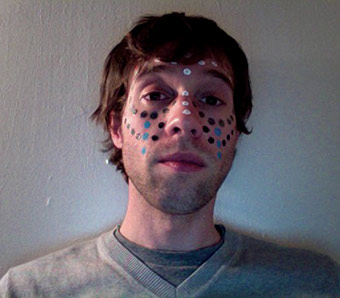Chris Fritton: Artist, Blogger

Get to know a Buffalonian...
Chris Fritton: Artist, Blogger
Fritton, letterpress print shop manager at the Western New York Book Arts Center and founder of the Buffalo Small Press Book Fair, is the creator of the blog/project i hid art (ihidart.tumblr.com). Built upon a simple premise, the blog is an arts exchange and scavenger hunt with a unique, whimsical interactivity. Fritton and other artists post images and clues to locations around town where they have hidden original artwork. Users are encouraged to track down the missing objects, photograph them and post back a short story detailing the find. Launched just two months ago, the project has since grown to include participants in Toronto and Rochester.
How did you first come up with the idea for i hid art and what are you hoping to accomplish through the project?
I hid art came from a game I played with a friend over ten years ago. We would hide things in library books and give each other the call number; you’d never knew what you’d find. It quickly moved from hiding 2-d things inside the books to hiding objects on the shelves. I always wanted a way to get other people involved, but technology was limited then and it just wasn’t feasible. Now that the technology is here, I’m hoping that it will give people a new way of seeing their city, especially the downtrodden areas. When you’re hiding art and finding art, every place you look becomes one of potential —the urban landscape is full of treasures, both real and figurative, but you have to work for them. Here in Buffalo, we have to work particularly hard.
How successful have your readers been at finding the art you’ve hidden?
Right now the success rate is well over 80%. There are avid hiders and finders that are out there almost every day—which is what I hoped for. But it also means if you want to get in on the action, you have to move fast. I like the idea that not all the art is found, some of it languishes in the elements, some gets found by people who aren’t even playing the game. I’m sure some art is even found, judged not to be someone’s taste, and put back. Other than the hiding and finding, there are no real rules. It’s not that I don’t care if things are found, it’s that I like to leave the project open to the aspects of chance and subjectivity as well.
Is there a moment of apprehension before you leave behind an artwork—that you’ve spent time and care on—in an obscure location not knowing its fate? Has anything unfortunate happened to a piece you’ve left behind?
There’s always a moment when you consider a piece being broken, lost to the weather, discarded by someone who assumes it’s garbage and doesn’t bother to check. That’s all part of the risk. You take a risk when you hide it. If it’s in a bad neighborhood or treacherous place, you take a risk when you find it. Of course every artist takes the original risk when they make the work, someone might not like what the find. A few pieces have suffered the indignity of being lost or broken, but less than 6 out of 100 so far!
Do you think finders appreciate your artwork more considering the effort that goes into uncovering them?
I like to think that i hid art sets up an alternative economy. In a city where few people can afford to buy art, it creates a system where you “pay” for art with your sweat, frustration, and curiosity. I think all of that changes the value of an artwork—the hiding, the finding, The consideration of introducing it into a different economy: the economy of lost and found.
How does Buffalo, spatially, lend itself to this project? Does it ever just feel like a big, empty city brimming with possibilities?
Buffalo, like all the Rust Belt cities, is so full of empty space. It has the infrastructure for a city twice its population. But it’s not that all that space is sheer potential, because it’s not. All that space is space to be considered: Is it a relict? Is it rebuildable? Is it useful? Is it beautiful? I want people to ask those questions. I want them to find the answers. I want them to think about what they can do in their city.
BONUS: What is it about typesetting and printing that are attractive to you as an artist? What is it about the medium that resonates despite the relative obsolescence of the technology?
The letterpress printing I do correlates with the i hid art project in any number of ways. Seeing the potential in the abandoned. Solving the problem of how to make the old and new work together. Doing things meticulously, methodically, and executing it in a way that —hopefully—makes people pay attention, see things differently, and ask questions. Something I print on the letterpress looks like nothing else because I use equipment that, for the most part, no longer exists or seems obsolete. Something you hide or find feels like nothing else, because you’re doing it in places, even cities, that seem obsolete. But the new found value you we place on these objects now proves that isn’t true.
BONUS: Your clues seem pretty easy, more like directions. Have you given any thought to making the search more difficult?
This is true, and it was initially on purpose. I believe that hidden art isn’t fun unless it’s found. So to get the ball rolling, I made things easy. I didn’t want people to get.
blog comments powered by Disqus|
Issue Navigation> Issue Index > v9n44 (Week of Thursday, November 4) > Chris Fritton: Artist, Blogger This Week's Issue • Artvoice Daily • Artvoice TV • Events Calendar • Classifieds |









 Current Issue
Current Issue